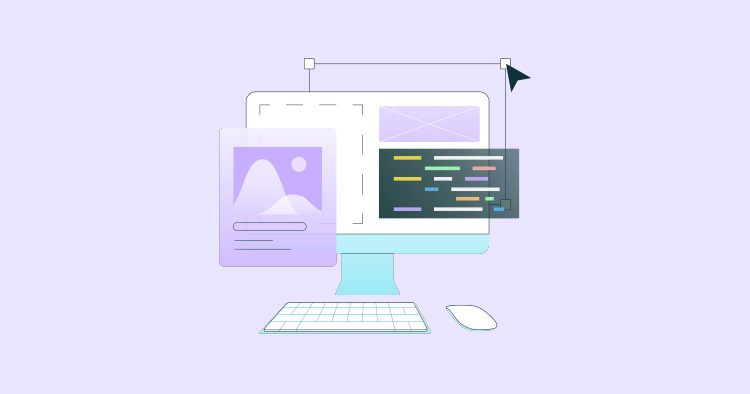A solid online presence is essential for any business to succeed in the modern marketplace. A well-designed website acts as your company’s online storefront, greeting customers and giving them a taste of your offer. It’s not just about looking good; your site must be easy to navigate and provide a positive user experience. But having a great website isn’t enough on its own. It would be best to get people there, which is where marketing comes in. Intelligent marketing strategies help you reach your audience and tell them why they should choose you over the competition. Combining a visually appealing, user-friendly website with targeted marketing campaigns creates a strong brand presence that can lead to increased customer loyalty and business growth.
Understanding the Basics of Web Design
Web design combines creativity and technical skills to build websites. It’s about creating a site that’s not only nice to look at but also works well and meets the needs of its users.
An excellent website should be easy to use, look good, and reflect your business’s personality. It should work well on all devices and web browsers, giving everyone a great experience.
HTML and CSS are the building blocks of web design. HTML structures your content on the web, and CSS adds style to it. Knowing these languages is critical to creating websites.
Planning Your Website
Before you design, figure out what you want your website to do and for whom. Your site could be for selling products, sharing information, or just showing off your work. It would be best if you designed it with these goals in mind.
Seeing what others in your industry are doing can teach you a lot. This research will help you decide what your website should look like and how it should work.
Planning your website’s structure and layout with a sitemap and wireframes is essential. This will help ensure visitors find what they need quickly and without hassle.
Choosing the Right Tools and Resources
Many web design platforms exist, including WordPress, Squarespace, and Wix. These can be helpful, especially for beginners, because they’re easy to use.
Select one of over 500 designs and establish your online presence.
- Free Web Hosting
- Fully Managed Solutions
- Scalable Websites
- No Hidden Cost
If you’re starting, tools like Adobe Photoshop for images, Sketch for interface design, and code editors like Sublime Text are handy. They’ll help you build and manage your site.
There’s no shortage of places to learn web design. Online courses, tutorials, and forums can all help. Check out sites like Codecademy, Udemy, and Lynda for courses aimed at beginners.
Design Principles and Best Practices
Creating a website that looks good and is easy to read is essential. This is where visual hierarchy and typography come in. Visual hierarchy helps you arrange your website elements so visitors can naturally understand what’s most important. For example, you might make your headlines big and bold so they stand out. Typography is about choosing the right fonts. The fonts should match your website’s style and make it easy for people to read your content.
The colors you choose for your website can make a big difference. They can affect how people feel about your site and make your brand more memorable. It’s important to pick colors that go well together and match the message you want to send. For example, blue evokes a sense of trust, whereas yellow can make your website feel energetic and enjoyable.
More and more people use their phones to go online, so ensuring your website works well on mobile devices is a must. Responsive design means that your site will look good and be easy to use no matter what size screen someone is viewing. This helps give everyone a great experience, whether on a phone, tablet, or computer.
Creating Engaging Website Content
Your website’s words should grab people’s attention and give them the information they need. Good web copy is clear, to the point, and persuasive. It keeps visitors on your site and encourages them to do something, like buy a product or sign up for a newsletter.
Pictures, videos, and other multimedia can make your website more enjoyable. They should be high quality and fit with the rest of your content. For example, a video tutorial can help explain a complex topic and a beautiful photo can make your homepage more inviting.
To get more people to visit your website, you must ensure it appears in search engine results. This means using the right keywords and creating valuable and engaging content. A website that’s easy to navigate and has excellent content will rank better in search engines and keep visitors returning.
Navigation and User Experience
Finding your way around a website should be easy. A straightforward menu helps people find the information they need quickly, which makes them more likely to stay on your site and have an enjoyable experience.
Select one of over 500 designs and establish your online presence.
- Free Web Hosting
- Fully Managed Solutions
- Scalable Websites
- No Hidden Cost
If you want people to contact you or sign up for something, your forms and contact pages must be simple. They should only ask for the information that’s really needed and make it easy for people to complete and submit them.
A great website is one that everyone can use, including people with disabilities. To achieve this, developers should include alt tags for images and ensure they incorporate keyboard navigation into the website. By focusing on accessibility, you can reach a wider audience and make your site more inclusive.
Incorporating SEO Techniques
SEO, or search engine optimization, is crucial for anyone building a website. It’s about understanding how search engines work and how to make your content appear higher in search results. This includes using keywords correctly and creating helpful content.
On-page SEO ensures you configure each page to rank well in search engines. This means having the correct titles, meta descriptions, and headings. Your content should also be top-notch and closely related to the topic.
Backlinks are links from other websites to yours. They help search engines see your site as trustworthy and relevant, which can improve your ranking. To get good backlinks, you need to create content that’s so good that other websites want to link to it. It’s also essential to follow good practices when getting backlinks, like reaching out to related websites and sharing your content online.
Integrating Social Media and Online Marketing
Social media platforms are invaluable for promoting your website and interacting with your audience. Whether you’re using Facebook to share updates, Instagram to showcase products, or Twitter to engage in conversations, these platforms can help increase your website’s visibility and draw more visitors.
Reaching out to your audience through email is a direct and personal way to connect. You can keep your customers engaged and informed by sending regular newsletters, special deals, and news about your website or services.
Understanding how your website performs and how visitors interact with it is crucial. Tools like Google Analytics offer insights that can guide you in making informed decisions, allowing you to tailor your website to better meet your audience’s needs.
Enhancing Website Speed and Performance
A website that loads quickly is likelier to keep visitors and perform better in search engine rankings. Slow websites can frustrate users, leading them to leave before seeing what you offer.
Images add visual appeal, but extensive files can bog down your site. Compressing images and reducing file sizes can speed up load times without sacrificing quality, ensuring a smoother experience for your visitors.
Caching saves your website’s files so they load quicker, while a CDN spreads your content across different servers. Both can significantly boost your website’s speed, making it more efficient for users worldwide.
Testing and Debugging Your Website
Ensuring your website works well across various devices and web browsers is essential. Testing should cover the design’s responsiveness, how quickly pages load, and that every feature works as intended.
A critical step in web development is finding and solving problems like broken links, coding mistakes, or issues with how your site appears on different browsers. Fixing these issues is vital for a smooth-running website.
Web analytics tools are essential for understanding user behavior and improving your website. They help you see what’s working and what isn’t, allowing you to make necessary adjustments to keep your site effective.
Launching and Maintaining Your Website
Your choice of web hosting provider is essential for your website’s success. Look for a host that offers excellent performance, support, and guaranteed uptime to ensure your site is always accessible.
Before going live with your site, ensure everything works as it should. Before launching your site, verify all the links, establish proper SEO efforts, and develop a marketing plan to promote your new site.
Regular maintenance is essential to keeping your website secure and up to date. This includes refreshing your content, monitoring your site’s performance, and making updates based on what you learn from user feedback and analytics.
Security and Privacy Considerations
Protecting your website with SSL certificates and secure payment gateways is a must. It reassures your visitors that their information is safe, crucial for building trust. More importantly, it shields your site from data breaches and cyberattacks, which are becoming increasingly sophisticated.
Your website must be a fortress for user data. A clear privacy policy, secure storage of user data, and adherence to privacy laws like the GDPR are non-negotiable. Ensuring your users’ privacy isn’t just about following rules; it’s about respecting your visitors and safeguarding their information as if it were your own.
Think of your website as a high-tech fortress that needs constant maintenance. Regularly updating your site’s software and backing up your data is key to securing it. It’s like having a safety net, ensuring that you can restore your digital presence quickly and efficiently if anything goes wrong.
Keeping Up with the Latest Trends
Web design is like fashion; it changes all the time. Staying on top of the latest styles, user experience enhancements, and tech innovations would be best to keep your website fresh and engaging. It’s not just about looking good—it’s about providing a seamless experience for your visitors.
To excel in web design, you must be a lifelong student. The industry constantly evolves with new tools, languages, and best practices. By dedicating yourself to learning and developing your skills, you ensure your web design work remains cutting-edge and practical.
Looking at successful websites can spark creativity and drive innovation in your projects. Analyze what makes these sites stand out and consider how to incorporate those elements into your work. It’s not about copying—it’s about learning from the best and finding your unique spin on proven successes.
Final Thoughts
Building a business is a journey that requires many tools, and two of the most important are web design and marketing. A thoughtfully designed website captures your brand’s personality and values, providing a home base for your customers. When you add effective marketing to the mix, your website transforms into a powerful tool for business expansion. It’s essential to keep up with new trends in design and marketing to stay relevant to your audience. As technology and consumer preferences change, so should your strategies. By staying innovative and adaptable, you can use your website and marketing efforts to distinguish your business in a competitive market and pave the way for long-term success.



